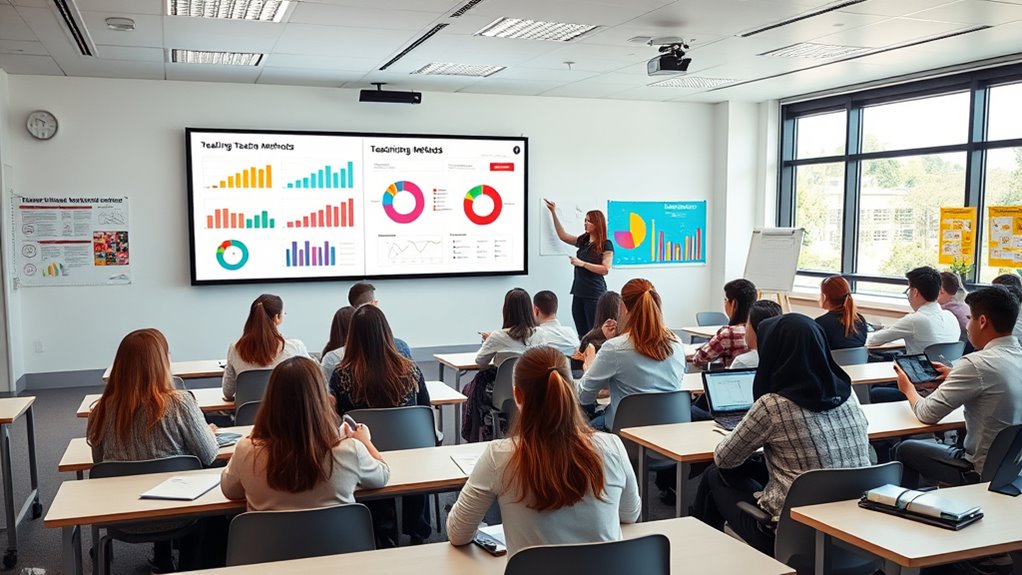Using statistical evaluation in education helps you identify which teaching methods work best by analyzing data like test scores and student engagement. You can compare strategies, measure their impact, and make data-driven decisions to improve learning outcomes. This approach supports ongoing refinement of your instructional practices and guarantees you’re using effective, evidence-based techniques. Keep exploring this topic further to discover how to implement these evaluations for lasting educational success.
Key Takeaways
- Statistical evaluation compares different teaching strategies using metrics like test scores and student participation.
- Data analysis assesses the impact of technology integration on student engagement and learning outcomes.
- Long-term trend analysis identifies sustained improvements or declines in teaching effectiveness over time.
- Quantitative measures of engagement help refine instructional methods to boost student involvement.
- Evidence-based evaluation supports continuous improvement and informed decision-making in educational practices.

Understanding the effectiveness of different teaching methods is crucial for improving educational outcomes, and statistical evaluation provides a clear way to compare their impacts. When you analyze data from various instructional strategies, you can identify which approaches truly enhance student learning and engagement. For example, by examining quantitative metrics such as test scores, attendance rates, and participation levels, you gain a clearer picture of what works best in your classroom. This process isn’t just about numbers; it’s about understanding how different methods influence student engagement and learning success. Supporting children through educational changes can also be facilitated by emotional support, helping students feel more secure and motivated in their learning environments. Student engagement is a critical factor in determining teaching effectiveness. When students are actively involved, they tend to retain information better and develop a more positive attitude toward learning. Statistical evaluation helps you measure engagement levels objectively—tracking participation, time-on-task, and interaction rates across different teaching approaches. If data shows that students participate more during lessons that incorporate interactive activities or group work, you’ll know that fostering such engagement strategies is worthwhile. This insight allows you to refine your methods, making your teaching more impactful by focusing on techniques that boost involvement and motivation. Technology integration is another significant aspect that statistical evaluation can illuminate. Incorporating digital tools, online platforms, and multimedia resources into your lessons might seem beneficial, but data analysis confirms whether these tools genuinely improve outcomes. For instance, you might compare test scores, assignment completion rates, or engagement metrics before and after implementing technology-based lessons. If the data indicates substantial improvement, it validates your decision to integrate technology. Conversely, if results are inconclusive or show no progress, you can re-evaluate and adjust your approach. This evidence-based method ensures you’re making informed choices about adopting new educational technologies. Furthermore, statistical evaluation enables you to identify patterns and trends over time, helping you understand the long-term effects of different teaching methods. It allows you to see whether improvements in student engagement and achievement are sustained or if they fluctuate. This ongoing analysis supports continuous refinement of your teaching strategies, ensuring you adapt to your students’ evolving needs. By relying on data rather than assumptions, you can confidently implement methods that have been proven to work, making your instructional practices more effective and aligned with best educational standards.
Frequently Asked Questions
How Do Cultural Differences Influence Teaching Method Effectiveness?
Cultural differences markedly impact teaching method effectiveness by shaping students’ learning preferences and expectations. You might notice cultural biases influencing engagement, as some students respond better to interactive approaches while others prefer traditional methods. Embracing pedagogical diversity helps you adapt your strategies, ensuring inclusivity and better learning outcomes. Recognizing these cultural nuances enables you to create a more effective, respectful classroom environment that caters to diverse student needs.
What Long-Term Impacts Do Teaching Methods Have on Student Success?
You’ll find that the long-term impacts of teaching methods really shape your students’ educational achievement and skill retention. When effective methods are used consistently, students build a strong foundation for future learning and career success. It’s like planting seeds for a fruitful harvest. By fostering critical thinking and resilience, you help students develop lifelong skills, ensuring they’re prepared to face challenges and excel beyond the classroom.
How Do Teacher Characteristics Affect Statistical Evaluation Results?
Your teacher traits, like experience and communication skills, can influence evaluation results because evaluation bias may occur if these traits sway observers’ perceptions. You might notice that a teacher’s charisma or confidence affects scores, making it harder to accurately gauge their effectiveness. By recognizing how these traits impact evaluations, you can work towards more objective assessments, ensuring that results truly reflect teaching quality rather than personal biases or superficial traits.
What Role Does Student Motivation Play in Teaching Method Outcomes?
Student motivation plays a vital role in teaching method outcomes. When you boost student engagement through effective motivation strategies, students become more active learners, which enhances understanding and retention. Motivated students are more likely to participate, ask questions, and stay focused, leading to improved results. Your ability to foster motivation directly impacts the success of your teaching approach, making it essential to incorporate engagement techniques that inspire and energize your students.
How Can Statistical Evaluations Be Adapted for Diverse Learning Environments?
You can adapt statistical evaluations for diverse learning environments by leveraging cutting-edge adaptive assessments that dynamically adjust to individual student needs. Conduct contextual analysis to understand unique classroom factors, guaranteeing your evaluations reflect real-world complexities. This approach transforms traditional methods into powerful tools, enabling you to accurately measure teaching effectiveness across varied settings. Embracing flexibility and context ensures your evaluations are as inclusive and precise as possible, revolutionizing educational insights.
Conclusion
As you explore the statistical evaluation of teaching methods, you realize how data shapes effective education. Sometimes, a surprising insight emerges just when you least expect it—like discovering a simple method that boosts student engagement unexpectedly. These coincidences remind you that behind every statistic is a story waiting to be uncovered. By embracing data-driven strategies, you can transform classrooms into dynamic learning spaces where success naturally follows curiosity and innovation.










